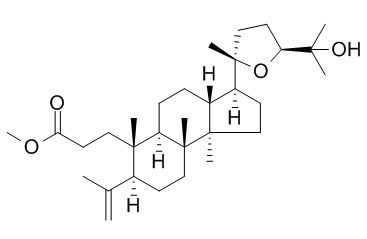Methyl eichlerianate
Standard reference
Inquire / Order:
manager@chemfaces.com
Technical Inquiries:
service@chemfaces.com
Tel:
+86-27-84237783
Fax:
+86-27-84254680
Address:
1 Building, No. 83, CheCheng Rd., Wuhan Economic and Technological Development Zone, Wuhan, Hubei 430056, PRC
Providing storage is as stated on the product vial and the vial is kept tightly sealed, the product can be stored for up to
24 months(2-8C).
Wherever possible, you should prepare and use solutions on the same day. However, if you need to make up stock solutions in advance, we recommend that you store the solution as aliquots in tightly sealed vials at -20C. Generally, these will be useable for up to two weeks. Before use, and prior to opening the vial we recommend that you allow your product to equilibrate to room temperature for at least 1 hour.
Need more advice on solubility, usage and handling? Please email to: service@chemfaces.com
The packaging of the product may have turned upside down during transportation, resulting in the natural compounds adhering to the neck or cap of the vial. take the vial out of its packaging and gently shake to let the compounds fall to the bottom of the vial. for liquid products, centrifuge at 200-500 RPM to gather the liquid at the bottom of the vial. try to avoid loss or contamination during handling.
Nat Commun.2021, 12(1):681.
BMC Plant Biol.2023, 23(1):239.
Kasetsart University2022, ethesis.1144.
J Pharmaceutical and Biomedical Analysis2022, 114631.
Molecules.2024, 29(5):1048.
Cancer Sci.2022, 113(4):1406-1416.
Genes Genomics.2020, 10.1007
Food Sci Nutr.2023, 11(9):5532-5542.
Journal of Mushroom2024, 22(4):192-198
Food Chem X.2024, 24:101794.
Related and Featured Products
Pertanika J. Sci. & Technol., 2014,22(1):163 - 74.
Chemical constituents of Aglaia lanuginose[Reference:
WebLink]
Our continuing research on the Aglaia genus (family Meliaceace) has led us to this first study on the chemical constituents of Aglaia lanuginose (bark).
METHODS AND RESULTS:
The dichloromethane extract from the bark of Aglaia lanuginose showed cytotoxicity against HL-60 leukaemia cell line (45% inhibition) at 20 μg/ml and was prioritised for further investigation. Repeated chromatography of the dichloromethane extract yielded the known dammarane triterpenes which were identified as cabralealactone (1), Methyl eichlerianate (2), cabraleone (3), ocotillone (4), eichleriatone (5), eichlerianic acid (6) and shoreic acid (7) together with the known sterols, sitosterol (9) and stigmasterol (10). Another isolated compound was the aromatic 4-hydroxycinnamyl-acetate (8), which has not been reported to be present in a plant from the Meliaceae family.The structures of all the compounds were elucidated on the basis of spectroscopic methods (IR, MS and NMR).
CONCLUSIONS:
Cytotoxicity testing of 1-10 showed activity only for mixtures of (3, 4), and (5, 6).



